 |
JAMES BOND
|
 |
JAMES BOND
|
|
||
|
|
“Trivial Pursuit” The first James Bond film, Dr. No released in 1962, began the custom of the ‘in-joke’ with the on-screen appearance of the recently stolen painting of The Duke of Wellington by Francisco de Goya, seen in the undersea hideout of the eponymous villain. Some of these ‘in-jokes’ and references have aged better than others, with very few of them detracting from the enjoyment of the film for those who don't spot them. In more recent years many apocryphal stories and bits of trivia surrounding the James Bond films have been perpetuated by so-called ‘Bond commentators’ and wannabee social media video channels. Most of these ‘facts’ are usually 100% untrue, and as is the case with many items appearing on publicly editable websites such as IMDB and Wikipedia, it is now easier for anyone to copy and republish information rather than verify if for themselves. With over 40 years’ experience and access to many of the filmmakers concerned, 007 MAGAZINE has been in the unique position of gathering facts from the horse's mouth, so to speak! 007 MAGAZINE takes a look back at those significant little ‘in-jokes’, cameo appearances and general trivia scattered throughout the James Bond films from 1962 to date, shedding a little more light on these often hard-to-spot ‘Easter eggs’ in the series that celebrated its 60th anniversary in 2022. |
||||
|
||||
|
Goya's painting was originally acquired by the Duke of Wellington himself, and remained in his family’s possession, and had descended to John Osborne, 11th Duke of Leeds by the time it was put up for auction at Sotheby's in 1961. New York collector Charles Wrightsman acquired the painting for £140,000, but questions about such an important work of art being exported were raised in the House of Commons. The portrait was subsequently offered to the National Gallery in London; with the Wolfson Foundation putting up £100,000, and the government adding a special Treasury grant of £40,000, to match Wrightsman's original bid. The painting was first put on display on August 2, 1961 and then stolen just nineteen days later on August 21, 1961. |
||||
|
||||
|
It was Dr. No co-scriptwriter Johanna Harwood who suggested the inclusion of the missing Goya painting in the undersea lair of the eponymous villain, and its appearance in the film was enthusiastically received by those cinemagoers who recognised it. The 2021 British comedy-drama film The Duke dramatized the story of the theft, recovery, and subsequent trial of Kempton Bunton, who confessed to stealing the portrait but voluntarily surrendered it in 1965 after several failed ransom demands over the four years it was in his possession. Read the full story here |
||||
|
||||
 |
||||
|
In the first James Bond film Dr. No (1962), Milton Reid (1917-1987) appears alongside stunt arranger Bob Simmons (1923-1987) as one of the two guards who beat up James Bond (Sean Connery) at Doctor No's dining table. Reid then appeared (also uncredited) as a temple guard in Casino Royale (1967) opposite Joanna Pettet and David Niven. Ten years later Reid then appeared as Sandor in The Spy Who Loved Me (1977) [this time credited] opposite Roger Moore as 007. Reid was also cast as a supporting player, frequently in Oriental makeup despite his British-Indian heritage, in four Hammer films released between 1958 and 1962. Alongside his acting career Milton Reid was also a professional wrestler, and attempted to secure the role of Oddjob in Goldfinger (1964). In January 1964 he challenged Harold Sakata (also a professional wrestler who fought under the name “Tosh Togo”) to a heavyweight battle. The fight ultimately never took place, but acted as publicity for the film, with a full-page piece in the Daily Mirror. Although Reid (who fought as “The Mighty Chang”) had more acting experience than Harold Sakata (1920-1982), the producers ultimately offered the key role in Goldfinger (1964) to the Hawaiian-born 1948 Olympic weightlifting Silver Medal winner. Also appearing as Temple Guard ‘Fred’ in Casino Royale (1967) is John Holliss, who would later appear as the bald-headed white cat-stroking villain [Blofeld but not named for fear of legal reprisals!] in the pre-credit sequence of For your Eyes Only (1981). Arnold Lee was a London-based Asian actor who made five uncredited appearances in the James Bond films. He first appeared as one of the decontamination technician's in Dr. No (1962), although it is impossible to identify him due to the actor wearing a distinctive anti-radiation safety suit. His next appearance was one of the Korean henchmen seen when Pussy Galore (Honor Blackman) discovers James Bond (Sean Connery) beneath the model of Fort Knox in Goldfinger (1964). He then played one of the two machine-gun wielding ‘assassins’ who fake Bond's death in Hong Kong during the pre-credit sequence of You Only Live Twice (1967). In 1983 Arnold Lee appeared as an auction bidder at SOTHEBY'S in Octopussy, and also as the Chinese Minister in Sean Connery's rival comeback film as 007, Never Say Never Again. Like so many of the Asian supporting players represented by the Oriental Casting Agency Limited, Lee's five Bond appearances went uncredited, although he was also a familiar face in many other British films and television series until his death in 2015. |
||||
|
||||
|
Also appearing in Dr. No (1962) as a decontamination technician, and later seen sat beside Joseph Wiseman in Doctor No's reactor control room is Anthony Chinn (1930-2000). The British based Guyanese actor then went on to appear as one of Goldfinger's servants in 1964; next playing the SPECTRE guard who operated the crater opening mechanism in Blofeld's volcano headquarters in You Only Live Twice (1967), before finally being ejected from Max Zorin's (played by Christopher Walken) airship by May Day (played by Grace Jones) in A View To A Kill (1985). Chinn was credited as Taiwanese Tycoon (billed as Anthony Chin) for his final performance in the James Bond series. Both Milton Reid and Anthony Chinn frequently appeared in villainous Oriental roles in a number of British-made films including two of the Pink Panther series. Perhaps Chinn's most notable later performance was as Mohan in Steven Spielberg's Raiders Of The Lost Ark (1981). Another familiar face from many British films and TV series in the Sixties was Cecil Cheng (1925-2003), who made brief uncredited appearances in three consecutive James Bond films. He was first seen as one of the many Korean henchmen in Goldfinger (1964), and then in Thunderball (1965) when he had a brief speaking role as ‘Number 7’ at the SPECTRE briefing early in the film. His final appearance was in You Only Live Twice (1967), where again he had a small speaking role as the control room technician who informs Blofeld (Donald Pleasence) that a radar blackout is in operation as the SPECTRE rocket is launched from their volcano headquarters in Japan. |
||||
|
||||
|
Also appearing in Goldfinger (1964) as Mr. Ling, was British-born actor Burt Kwouk (1930-2016). Raised in Shanghai, the actor is best-known for playing Cato Fong, Inspector Clouseau's manservant, in the Pink Panther film series. The character was first introduced in A Shot In The Dark (1964), the second film in the franchise, and was a role that Kwouk would reprise on another six occasions. Kwouk also appears uncredited in Casino Royale (1967) as a Chinese General at Le Chiffre's art auction, and in the same year credited as ‘SPECTRE 3’ in You Only Live Twice, although unusually on this occasion his dialogue was re-voiced by Robert Rietty. Appearing in Casino Royale (1967) as Le Chiffre's representative at the art auction (below right) was Polish-born actor Vladek Sheybal (1923-1992), who had memorably played Kronsteen (below left) in the second James Bond film, From Russia With Love (1963). Sheybal shared one of his scenes with German-born actor Walter Gotell as Morzeny, who himself would return to the series as General Gogol in The Spy Who Loved Me (1977) - a role he would reprise in the next five James Bond films. |
||||
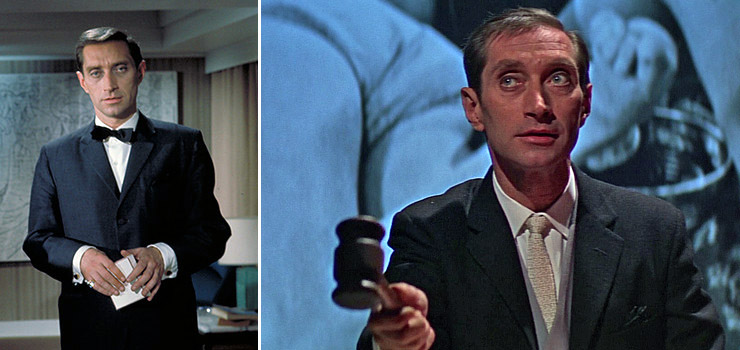 |
||||
|
Another actor who would appear in five James Bond films over a 40-year period, was Jamaican-born Vincent Wong (1928-2015), who like Burt Kwouk and Anthony Chinn had cornered the market playing villainous Oriental characters in many British films and TV series. Having previously appeared as henchmen in Goldfinger (1964), Wong was memorably featured as the face of the title character on the cover of the 1968 PAN paperback of COLONEL SUN by Kingsley Amis (writing as Robert Markham). Vincent Wong then appeared as the casino croupier in the pre-credit sequence of Diamonds Are Forever (1971), later as a Stromberg henchman in The Spy Who Loved Me (1977), and then as a casino guest seen being manhandled out of the gaming room by Valentin Zukovsky's (Robbie Coltrane) henchmen in The World Is Not Enough (1999). Vincent Wong also briefly appeared in the music video for ‘The World Is Not Enough’ title song performed by Garbage. His final and only credited appearance in a James Bond film was as General Li in Die Another Day (2002). |
||||
|
||||
|
Lenny Rabin was another actor playing different characters in the James Bond series, and first appeared as one of the American Gangsters in Goldfinger (1964). This was followed by an appearance as one of the casino gamblers in On Her Majesty's Secret Service (1969); a Stromberg Crewman in The Spy Who Loved Me (1977) [his only credited performance]; one of the ski-jump spectators in the lift with James Bond (Roger Moore) as he arrives at the Cortina winters sports event in For Your Eyes Only (1981), and finally as one of the bidders at the SOTHEBY'S auction in Octopussy (1983). British-based Canadian actor Shane Rimmer played a NASA technician [uncredited] in You Only Live Twice (1967), Tom [also uncredited] in Diamonds Are Forever (1971), and USS Wayne Captain Carter in The Spy Who Loved Me (1977). In addition to his three on-screen appearances, Shane Rimmer also provided the voice of Hamilton (played by Bob Dix) - once again uncredited - which amounted to just one line of dialogue in the pre-credit sequence of Live And Let Die (1973). |
||||
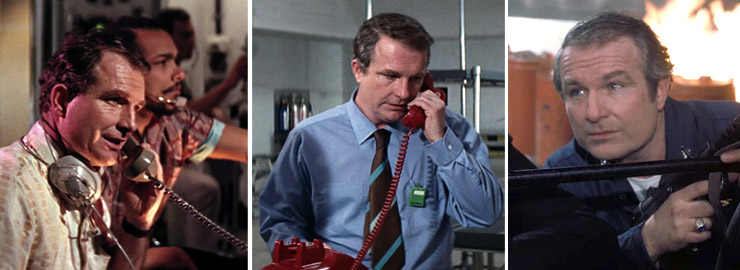 |
||||
|
Later repeat appearances from henchmen in different films include Terence Mountain (1936- ), who appeared as Raphael in On Her Majesty's Secret Service (1969), and then uncredited as one of Blofeld's guard's in the pre-credit sequence of Diamonds Are Forever (1971). Sean Connery's comeback as James Bond also saw Marc Lawrence (1910-2005) appear as one of the Slumber Inc. attendants who throws Plenty O'Toole (Lana Wood) out of Bond's Las Vegas hotel room window. Lawrence was uncredited in Diamonds Are Forever (1971), but three years later appeared as Rodney in the pre-credit sequence of The Man With The Golden Gun (1974), where he is dispatched by Christopher Lee as Scaramanga in the pre-credit funhouse sequence. Irvin Allen who played Che Che, one of Draco's henchmen in On Her Majesty's Secret Service (1969), next appeared as the waiter who serves Bond in the Fillet of Soul New York in Live And Let Die (1973), and later as a Stromberg Crewman in The Spy Who Loved Me (1977). |
||||
|
||||
|
The 1967 spoof version of Casino Royale featured several performers who had appeared in earlier James Bond films, or would go on to play another role in a later film in the EON Productions series. Peter Burton (1921-1989), who had played MI6 Armourer Major Boothroyd in Dr. No (1962), pops up [uncredited] in Casino Royale as the second of the agents tested by Moneypenny (Barbara Bouchet) as part of Sir James Bond's (David Niven) ‘Anti-Female Spy Defence’ initiative, before Cooper [Terence Cooper (1933-1997]) convinces her that he is the man for the job! Also appearing in Casino Royale as Buttercup [one of M's (John Huston) many daughters] is English actress Angela Scoular (1945-2011), who went on to play Ruby Bartlett in On Her Majesty's Secret Service (1969). Burmese-born actress Jeanne Roland (1937- ), has two small roles in Casino Royale - firstly as Ting Ling [uncredited], one of the girls Cooper must resist as part of his AFSD training; and later as the machine gun-toting ‘Captain of the Guards’, and the only one of the Guard Girls to be credited at the end of the film. Jeanne Roland next played Bond's (Sean Connery) masseuse in You Only Live Twice (1967). English actress, model and singer Caroline Munro (1949- ) was one of many other uncredited performers in Casino Royale (playing one of Dr. Noah's Guard Girls), but went on to have memorable career in horror, science fiction and action films of the 1970s and 1980s; including a supporting role in the 1977 James Bond film The Spy Who Loved Me, as Stromberg's (Curt Jurgens) murderous helicopter pilot Naomi. English actor, writer and satirist John Wells (1936-1998) played Q's (Geoffrey Bayldon) assistant in Casino Royale, and would have a cameo role at the end of For Your Eyes Only (1981) as Denis Thatcher opposite Janet Brown (1923-2011) playing then Prime Minister Margaret Thatcher. |
||||
|
||||
 |
||||
|
Director Terence Young (1915-1994) actually appeared on screen as James Bond when he used his own hands during close-up insert shots in the first two films of the series. ‘Inserts’ are often filmed separately from the main action, by which time the principal actors are usually not present on set. Young therefore used his own hands in Dr. No for a close-up when James Bond (played by Sean Connery) places a strand of hair across two doors in his Kingston hotel bedroom to check for intruders. It is also Young who writes ‘From Russia With Love’ on the file photograph of Tatiana Romanova (played by Daniela Bianchi) in the second film of the series. Young would also stand in for other actors on set, although these contributions did not make it into the finished film. It is also Terence Young's voice that can be heard on the telephone as British Consul official Paul Maxwell at the end of From Russia With Love (1963), as James Bond (Sean Connery) is confronted in his Venice hotel room by Rosa Klebb (Lotte Lenya) disguised as a maid. |
||||
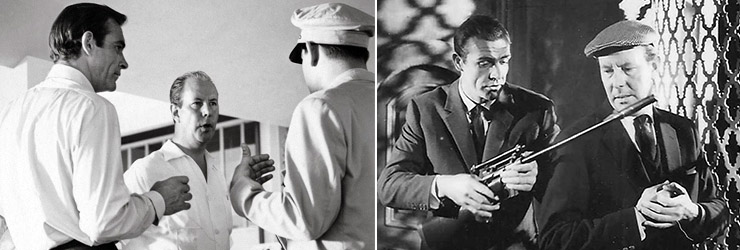 |
||||
|
Director Terence Young was one of the most important contributors to the success of the early James Bond films. He was the one who moulded Sean Connery into the character of James Bond - a personality so different from the actor himself. When interviewed about the films in the 1980s Young said: “I directed the first, I directed the best, and I directed the most successful”; but when asked what were the three key ingredients in the success of the James Bond films he replied: “Sean Connery, Sean Connery and Sean Connery!” The pair remained close friends until Young's death in 1994, and Connery always acknowledged the director's significant contribution to the series. Young was involved in the pre-production of Goldfinger (1964) and originally slated to direct the third 007 adventure, but left the project in late 1963 after failing to negotiate a better financial contract with the producers, and Guy Hamilton replaced him. Terence Young returned to direct Thunderball (1965) which is still the most commercially successful film of the series when not adjusted for inflation. |
||||
|
||||
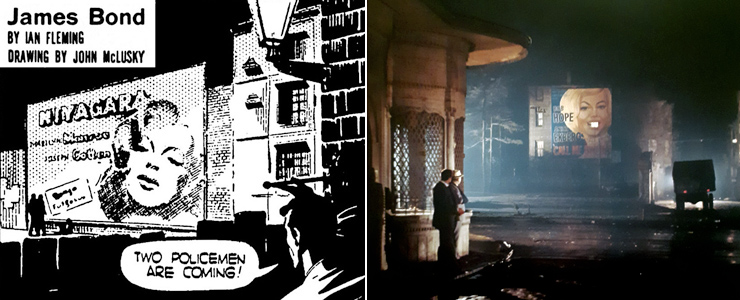 |
||||
|
In Ian Fleming's 1957 novel FROM RUSSIA, WITH LOVE, James Bond and Kerim Bey track down Bulgarian gangster Krilencu to his Istanbul hideout in a building behind a huge billboard advertising the 1953 Marilyn Monroe film Niagara. Krilencu's room was conveniently located behind the mouth of the actress in the poster. Kerim Bey shoots Krilencu as revenge for the bomb attack which almost cost him his life earlier in the story. For the 1960 Daily Express comic strip adaptation of FROM RUSSIA, WITH LOVE illustrated by John McLusky, the poster is translated into Turkish (as it had been in the novel), but the 1963 film version swaps the poster for the recently released comedy Call Me Bwana, which was made by EON Productions, and directed by Gordon Douglas (1907-1993). The assassination of Krilencu (played by Fred Haggerty) was expertly staged in From Russia With Love by director Terence Young, with only minor changes to the dialogue in the novel. |
||||
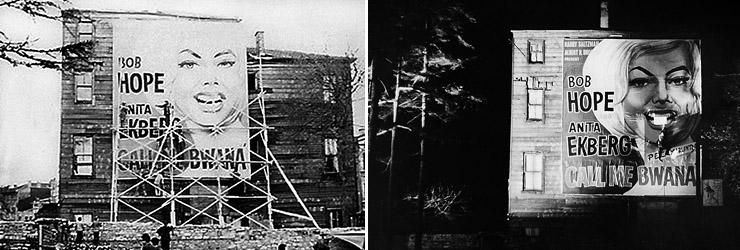 |
||||
|
Although set in Kenya, Call Me Bwana was shot largely at Pinewood Studios following the completion of Dr. No (1962). The script was co-written by Johanna Harwood (who also adapted Dr. No and From Russia With Love for the screen), photographed by seven-time James Bond cinematographer Ted Moore and featured a musical score by ‘The James Bond Theme’ and Dr. No composer Monty Norman. Five-time James Bond editor Peter Hunt, who would go on to direct On Her Majesty's Secret Service, performed the same duties for Call Me Bwana. Now largely forgotten, the film starred popular American (but British-born) comedian and actor Bob Hope (1903-2003), and Swedish actress Anita Ekberg (1931-2015), who at the time was married to American actor Rik Van Nutter, who would later play Felix Leiter in Thunderball (1965). Ekberg was perhaps most famous for her scene in Federico Fellini's La Dolce Vita (1960), where she is seen cavorting in Rome's Trevi Fountain alongside Marcello Mastroianni, which has been called one of cinema's most iconic scenes. Ekberg’s entire vocal performance in Call Me Bwana was revoiced by Nikki Van der Zyl (1935-2021). Anita Ekberg was initially considered for the role of Honey Ryder, ultimately portrayed by Ursula Andress in Dr. No (1962). Ekberg would attend the Gala Premiere of the first James Bond film at the London Pavilion on October 5, 1962 whilst in England shooting Call Me Bwana, and is often mistakenly identified as Andress by press agencies when captioning photographs from the event. Ursula Andress did not attend the premiere as she was filming Fun In Acapulco (1963) at the time in the USA with Elvis Presley. |
||||
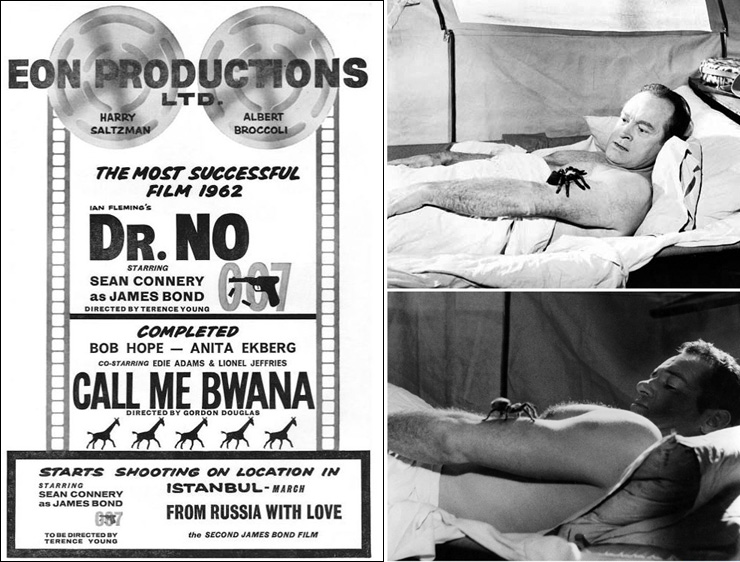 |
||||
|
Call Me Bwana was released after Dr. No, and also featured a spoof of the spider sequence from the first James Bond film, this time with Bob Hope menaced by the killer arachnid. In both films stuntman Bob Simmons (1923-1927) stood in for the leading actor for those close-ups involving the real tarantula. A production still from the sequence is frequently credited as being from Dr. No (1962), when in fact it was from the re-creation scene in Call Me Bwana (1963) - as evidenced by the tent flap visible in the background [pictured above]. Call Me Bwana was the only non-Bond film co-produced by Harry Saltzman (1915-1994) and Albert R. Broccoli (1909-1996), and remained the only non-Bond film from EON Productions until the British drama The Silent Storm was released in 2014. Albert R. Broccoli's musical-fantasy film version of Ian Fleming's Chitty Chitty Bang Bang (1968) was made by his own production company Warfield Productions. |
||||
|
||||
|
||||
|
Prior to the release of Dr. No in 1962, producers Harry Saltzman & Albert R. Broccoli founded a company responsible for the copyright and trademarks to the characters, elements, and other material related to James Bond on screen. The company was called DANJAQ, a combination of Broccoli & Saltzman's respective wives’ names Dana (1922-2004) and Jacqueline (1929-1980). Their sister company EON Productions was responsible for the actual making of the films. Both of the producers wives would have brief uncredited cameo appearances in the series. In From Russia With Love (1963) Jacqueline Saltzman can be briefly glimpsed as a passenger on board the Orient Express as it pulls into Zagreb Station. Dana Broccoli had an equally brief cameo in Thunderball (1965). |
||||
|
||||
|
||||
|
In the scene immediately following the cameo appearance of Jacqueline Saltzman, viewers can see Captain Nash waiting at Zagreb Station for his pre-arranged meeting with James Bond. Donald Grant (Robert Shaw) leaves the Orient Express at Zagreb ahead of Bond after overhearing the Secret Service code signal exchanged between 007 and Kerim Bey's son Mehmet (Nushet Ataer) at Belgrade Station. Grant then kills Captain Nash off-screen and assumes his identity. The non-speaking role of Captain Nash was played by From Russia With Love's Production Manager Bill Hill (born Edward William Hill in 1921) - a role he also performed on the previous EON Productions film Call Me Bwana (1963). Later in his career Bill Hill was the associate producer of Alfred Hitchcock's Frenzy (1972), and John Huston's The Man Who Would Be King (1975) starring Sean Connery and Michael Caine. |
||||
|
||||
 |
||||
|
In From Russia With Love (1963) during the sequence on board the Orient Express when Bond and Kerim (Pedro Armendariz) discuss their escape plan, a woman passes in-between them in the corridor. The small uncredited role was played by Phyllis Cornell who was the stand-in for actress Daniela Bianchi, and would also perform the same duties for Tania Mallet in Goldfinger (1964). Phyllis Cornell's most prominent on-screen appearance in the James Bond films was as the stunt double for Honor Blackman during the barn fight with Sean Connery in Goldfinger (above right). |
||||
|
||||
|
Over the years the myth that James Bond author Ian Fleming makes an uncredited cameo appearance in From Russia With Love (1963) has perpetuated in print, and now still frequently repeated online. Presumably this non-fact was started by so-called ‘armchair experts’ watching indistinct copies of the film on TV and video, and assuming the man beside the tracks is Ian Fleming as they had seen similar photographs of him in front of a train. Whilst it is true the best-selling author was present on location for some shooting of the exteriors of the Orient Express sequence when he visited the cast in Turkey, he is not the person seen standing beside the train as it fails to make a prearranged stop at a crossroads following the murder of Kerim Bey. |
||||
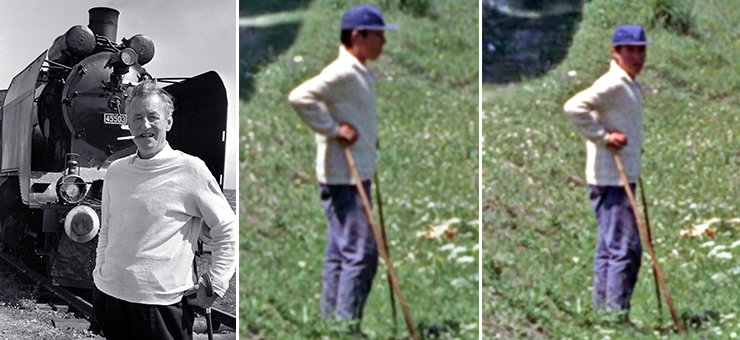 |
||||
|
Photographs of Ian Fleming on location with Sean Connery and co-producer Harry Saltzman (below left) clearly show him sitting on a shooting stick (a traditional British combined walking stick and folding chair). Other photographs show Fleming wearing a cream pullover and again using the same shooting stick. Ian Fleming was also photographed in front of an engine with the registration #45503 [still operational as late as 1974], which is not the same one seen in the sequence in the From Russia With Love (steam locomotive #56501 is seen at approximately 76 minutes into the film) where a man wearing a white jacket with a collar, and holding two much longer wooden sticks, stands beside the track as the train steams past. The much younger black-haired, vaguely oriental looking man, wearing a blue cap is clearly not Ian Fleming - a fact corroborated by director Terence Young and editor Peter Hunt in their many conversations with 007 MAGAZINE. The fact that cows can be seen beside the tracks during the sequence indicate this person was probably just a local tending his animals as the second-unit crew captured their shots of the speeding train! |
||||
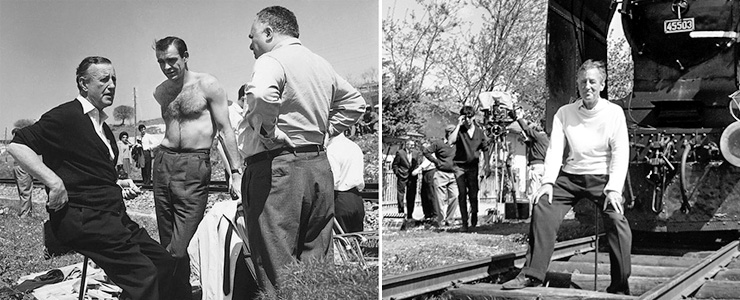 |
||||
|
|
||||
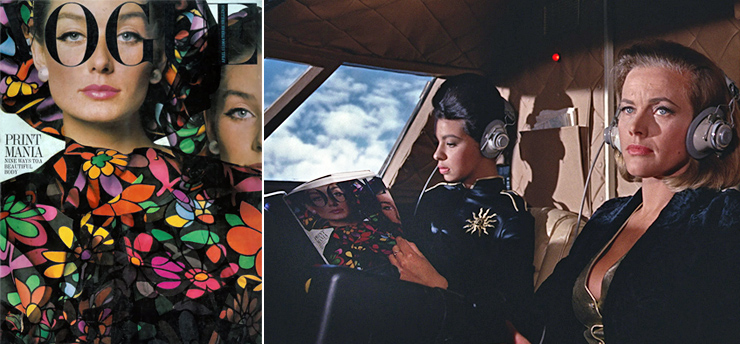 |
||||
|
English model and actress Tania Mallet appeared in Goldfinger (1964) as Tilly Masterson, sister of the ill-fated ‘Golden Girl’ Jill (played by Shirley Eaton). Mallet's brief appearance in Goldfinger was her only big-screen role, but after being killed by Oddjob's lethal hat, she appears again in the film on the cover of the April 1964 issue of Vogue magazine which is being read by Pussy Galore's co-pilot Sidney (played by Tricia Muller [uncredited]). As one of Britain's top models, Mallet made several appearances in and on the cover of Vogue - the popular American fashion and lifestyle magazine launched in 1892. For her appearance on the April 1964 British edition of Vogue, Mallet wore a Bodin printed silk cardigan jacket by Julian and a matching hat by Dolores. The cover image was by celebrated British fashion photographer David Bailey (1938- ). |
||||
|
||||
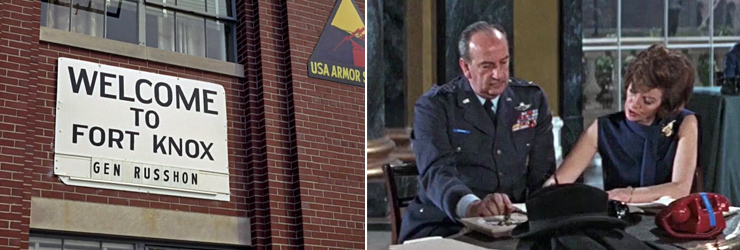 |
||||
|
Retired US Air Force Officer Lt. Col. Charles Russhon (1911-1982), whose military connections and expertise added greatly to the authenticity of the sequences he was involved with, was rewarded with two cameo appearances in the James Bond films. Through his military connections, Russhon negotiated with the Turkish authorities for the use of land in Istanbul during the making of From Russia With Love (1963). In 1964 he obtained the rights to use Fort Knox for Goldfinger. Although the filmmakers were not allowed to shoot inside the gold depository, permission was granted for the use of the United States Army base and exterior of the bullion depository, seen in the fly-past by Pussy Galore's Flying Circus in the film. A large-scale exterior set was replicated at Pinewood Studios by Production Designer Ken Adam for the scenes involving Goldfinger's attack on the depository, and interior scenes of the gold vault. Goldfinger is the only James Bond film where Charles Russhon received a formal screen credit. The producers also acknowledged his help with an on-screen ‘in-joke’ (and a military promotion!) with his name appearing on a WELCOME TO FORT KNOX sign on the USA Armor School building, Fort Knox, Kentucky (above left). |
||||
|
||||
|
||||
|
In June 1964 screenwriter Richard Maibaum submitted his 49-page treatment of On Her Majesty's Secret Service, which was originally intended to be the fourth James Bond film starring Sean Connery after Goldfinger (1964). Following his acquisition of the screen rights to THUNDERBALL in December 1963, after winning the high-profile case against author Ian Fleming in the High Court, Irish filmmaker Kevin McClory announced that he planned to release a film version of the novel just as shooting on Goldfinger had begun. American producer Charles K. Feldman who owned the rights to Ian Fleming's first James Bond novel CASINO ROYALE, and alongside Columbia Pictures, had been negotiating with EON Productions throughout 1964 to jointly produce a film version which would star Sean Connery. The filmmakers could ultimately not agree terms and Feldman decided to produce the film himself, but it would take two more years to actually go into production. Meanwhile in February 1964, Kevin McClory had announced in the press that Richard Burton would star as James Bond in his version of THUNDERBALL, so Harry Saltzman & Albert R. Broccoli faced another rival film to challenge their ongoing success. Goldfinger premiered at the ODEON Leicester Square on September 17, 1964 and went on to break box-office records across the UK. The original UK film prints of Goldfinger bore the end credit announcing On Her Majesty's Secret Service as the next film in the series. However, the spectre of Kevin McClory wouldn't go away, and in September 1964 Albert R. Broccoli flew to Dublin, and EON Productions reluctantly went into partnership with the Irishman. A new end credit was hastily created for Goldfinger, and subsequent prints struck for the UK (and all US prints in readiness for the Christmas 1964 release) correctly named Thunderball as the next film in the series. |
||||
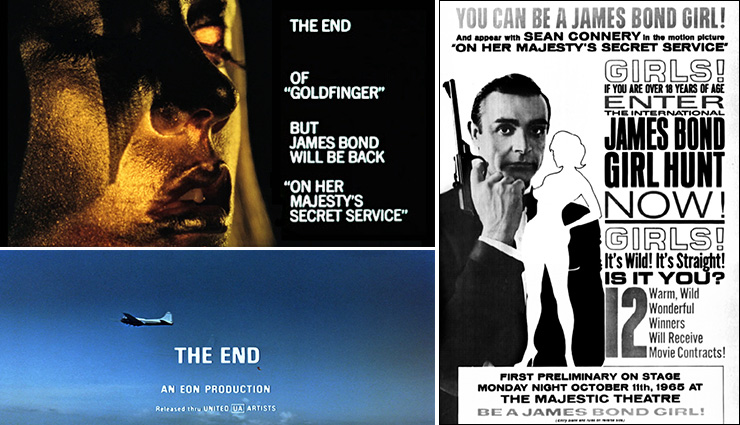 |
||||
|
Thunderball was then filmed with Kevin McClory as the sole credited producer, but a planned premiere at London's ODEON Leicester Square on October 21, 1965 was postponed due to post-production delays. The fourth James Bond film was first released in Japan on December 9th, with the UK opening celebrated by two lavish gala premieres at the London Pavilion and Rialto cinemas on Wednesday December 29, 1965. As Thunderball geared up for its release, pre-production on the follow-up was already underway. EON reinstated On Her Majesty's Secret Service as the next instalment to star Sean Connery, and even instigated a ‘James Bond Girl Hunt’ with a talent show to find the next co-star! The original end credits for Thunderball did contain the caption announcing On Her Majesty's Secret Service as the next film in the series, however the success of the first three films in Japan prompted the producers to change their mind again, and You Only Live Twice became the fifth 007 adventure to star Sean Connery. The end credits of Thunderball were revised before the actual release of the film and removed the reference to the next film in the series, resulting in a clumsy optical wipe. Many fans bemoan the fact that when On Her Majesty's Secret Service did finally reach the screen in 1969, it was with newcomer George Lazenby, and not Sean Connery, who came very close to actually appearing in the film twice before. |
||||
|
|
||||
|
||||
|
Thunderball (1965) was the first EON Productions James Bond film not to be produced by Harry Saltzman & Albert R. Broccoli. Kevin McClory, the Irish film producer and screenwriter, acquired the rights to the story THUNDERBALL after he successfully sued Ian Fleming for plagiarism and false attribution of authorship of the novel following its publication in 1961. The case reached the High Court in late 1963, and as part of the settlement, McClory received a co-writing credit in subsequent printings of the novel, and worldwide film rights to the story. Kevin McClory immediately exercised his rights to Thunderball and announced his own film version to star Richard Burton as James Bond. Rather than have McClory release a rival Bond film, EON Productions reluctantly went into partnership with the Irishman, and agreed to make Thunderball as the fourth James Bond film with McClory receiving sole producer credit on the film. Under the terms of the deal, EON licensed McClory's rights for a period of ten years. McClory made an uncredited cameo in Thunderball, puffing on a cigar as James Bond (played by Sean Connery) enters the Cafe Martinique in Nassau. McClory was later one of the invited guests to the Royal World Charity Premiere of On Her Majesty's Secret Service (1969). |
||||
|
||||
|
After the 10-year embargo had elapsed, McClory made plans to produce another film version of the story he had co-authored with Ian Fleming and screenwriter Jack Whittingham. Securing the services of former James Bond Sean Connery, McClory teamed with author Len Deighton in 1975, and the trio fashioned a script entitled ‘James Bond of the Secret Service’, which by 1978 had evolved into ‘Warhead’. Deighton ultimately withdrew from the project, and the film was eventually made in 1983 as Never Say Never Again. McClory spent much of his life from 1963 to his death in 2006 trying to make James Bond films, and entering into legal proceedings with EON Productions, based on his ownership of the rights to Thunderball. On November 15, 2013, MGM and DANJAQ LLC (the company that holds the copyright and trademarks to the characters, elements, and other material related to James Bond on screen), announced they had acquired all rights and interests relating to the James Bond character from McClory's estate. MGM, DANJAQ, and the McClory estate issued a statement saying that they had brought to an “amicable conclusion the legal and business disputes that have arisen periodically for over 50 years.” |
||||
|
||||
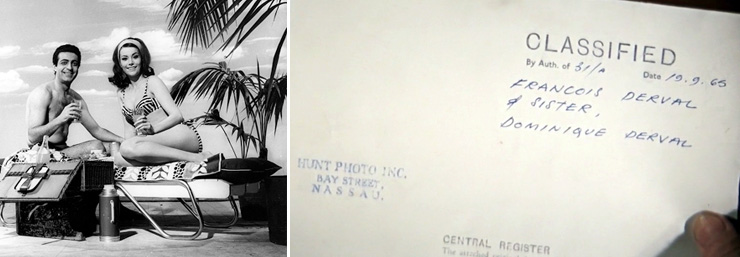 |
||||
|
Thunderball editor Peter Hunt made a brief ‘cameo’ in the film in the form of a rubber stamp bearing the details ‘HUNT PHOTO INC. BAY STREET, NASSAU’ appearing on the back of François Derval's MI6 file photograph handed out to all ‘00’ agents in the film. The names on the back of the Hunt Inc. photograph are hand-written by Thunderball director Terence Young! The photograph of Paul Stassino and Claudine Auger was photographed on a soundstage at Pinewood Studios, with the pair sitting on one of the beach loungers previously seen during the Pinewood shot Fontainebleau Hotel sequence at the beginning of Goldfinger (1964), and later owned by Daily Express James Bond comic strip artist john McLusky! After editing the first five James Bond films [and serving as second-unit director on You Only Live Twice (1967)], Peter Hunt made his directorial debut with On Her Majesty's Secret Service (1969) starring one-time James Bond George Lazenby. Hunt also appears in an uncredited cameo as the reflection seen in the Universal Exports sign as the first image of the film after the opening gun barrel sequence [pictured below right]. |
||||
 |
||||
|
|
||||
|
||||
|
Perhaps the hardest to spot of all cameo appearances in the James Bond films is that of Dana Broccoli (1922-2004) in Thunderball (1965). For eagle-eyed viewers she can be briefly glimpsed dancing in the background between Largo (played by Adolfo Celi) and James Bond (played by Sean Connery) at the Cafe Martinique in Nassau with Thunderball Production Supervisor David Middlemas (1919-2001), who worked in the same capacity on the next two films in the series [and Chitty Chitty Bang Bang (1968)], before being promoted to Production Manager on The Spy Who Loved Me (1977). |
|
|||||
|
|
|||||
|
Another small cameo role in Thunderball was played by Diane Hartford (above left) as the girl in the ‘Kiss Kiss Club’, who James Bond dances with before Fiona Volpe (played by Luciana Paluzzi) cuts in. Although uncredited in the film, Hartford does have one line of dialogue - “You should have told me your wife was here”. At the time of shooting Thunderball, Diane was married to George Huntington Hartford II (1911-2008), the American businessman, philanthropist, stage & film producer, and art collector. Huntington Hartford was also heir to the A&P supermarket fortune and owned Paradise Island in The Bahamas, which served as a filming location in Thunderball and Casino Royale (2006). 40-years later Diane Hartford also appeared in Casino Royale, this time credited as ‘Card Player’ at the ‘One And Only Ocean Club’, and is seen at the poker table (above right) next to Alex Dimitrios (Simon Abkarian). Diane says a brief “Good evening” to James Bond (Daniel Craig) as he joins the game. |
|||||
|
|||||
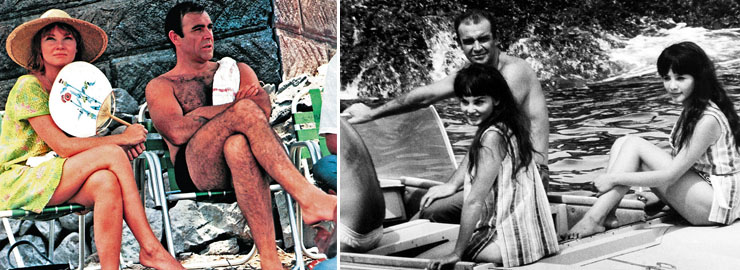 |
|||||
|
After the filmmakers discovered that Mie Hama (playing Kissy Suzuki whose character is never actually named in the film) couldn't swim, Sean Connery's then-wife, Australian-born actress Diane Cilento (1932-2011), doubled for Hama in the swimming scenes in You Only Live Twice, wearing a black wig. Connery and Cilento had married in 1962, had one child Jason born in 1963, and divorced in 1973. Cilento had a successful television career prior to marrying Sean Connery, also appearing in many films including the multi-award-winning Tom Jones (1963) [alongside Albert Finney], for which she was nominated for an Academy Award as Best Supporting Actress. After the divorce from Sean Connery, Diane Cilento appeared opposite Christopher Lee and Britt Ekland in the cult-classic The Wicker Man (1973) written by acclaimed English playwright, screenwriter and novelist Peter Schaffer (1926-2001). Diane Cilento and Peter Schaffer later married in 1985, and the pair remained together until his death. |
|||||
|
|||||
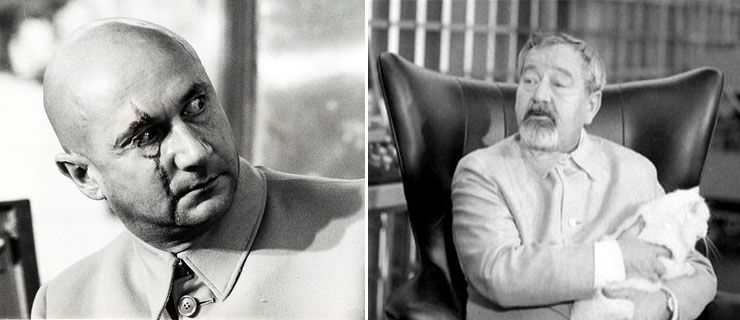 |
|||||
|
You Only Live Twice is the first film in the series where the face of Ernst Stavro Blofeld, the villainous leader of SPECTRE is revealed. Several actors were considered for the prime role, but it was Austro-Hungarian actor Jan Werich (1905-1980) who was originally cast as Blofeld at the suggestion of co-producer Harry Saltzman. Jan Werich (pronounced Yan Vareek) was primarily a stage actor and had the nickname ‘The Wise Clown’, but unfortunately spoke very little English. After just five days shooting on the Volcano set at Pinewood Studios, and posing for publicity photographs in November 1966, the filmmakers realised that Werich wasn't menacing enough, with director Lewis Gilbert saying he more resembled Father Christmas! Werich was replaced at very short notice by British actor Donald Pleasence (1919-1995), who brought a more silkily evil persona to the role, despite being similarly short in stature. Pleasence also wore the facial scarring makeup that became so linked to the character that it was spoofed by American actor Mike Myers in the ‘Austin Powers’ film series. Ironically, neither of the two actors who next played Blofeld in the EON Productions series had the scar. Telly Savalas had the bald head in On Her Majesty's Secret Service (1969), but Charles Gray had a full head of hair in Diamonds Are Forever (1971)! Even John Holliss, who played the wheelchair-bound character in the pre-credits sequence of For Your Eyes Only (1981) [who was clearly meant to be Blofeld, but unnamed in the film for fear of legal action] had the familiar bald head. It was only in Spectre (2015), which featured the return of the eponymous crime organisation led by the arch-villain, that Blofeld (now played by Christoph Waltz), re-acquired his trademark facial scar, and lost one eye following the destruction of his Moroccan hideout. |
|||||
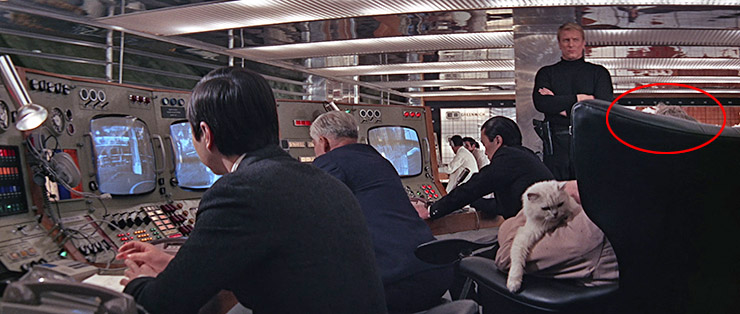 |
|||||
|
The back of Jan Werich's head (circled in red above) can be briefly glimpsed in a couple of shots in You Only Live Twice (1967) in part of the sequence just before James Bond is brought into the control room. Werich filmed the meeting between Bond and Blofeld during his five day's work on the film, but the sequence was re-shot with Donald Pleasence a week after Werich's departure in late-November 1966. It is very possible that other shots of Werich's hands can be seen stroking Blofeld's trademark white cat in the film. |
|||||
|
|
FACT FILES - UK Posters | ||||